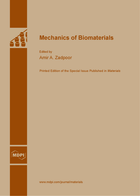Mechanics of Biomaterials
A special issue of Materials (ISSN 1996-1944). This special issue belongs to the section "Biomaterials".
Deadline for manuscript submissions: closed (28 February 2015) | Viewed by 152862
Special Issue Editor
Interests: biofabrication and additive bio-manufacturing; mechanobiology; surface bio-functionalization; infection prevention and treatment; metamaterials
Special Issues, Collections and Topics in MDPI journals
Special Issue Information
Dear Colleagues,
The mechanical behavior of biomedical materials and biological tissues are important for their proper function. This holds true, not only for biomaterials and tissues whose main function is structural such as skeletal tissues and their synthetic substitutes, but also for other tissues and biomaterials. Moreover, there is an intimate relationship between mechanics and biology at different spatial and temporal scales. It is therefore important to study the mechanical behavior of both synthetic and living biomaterials. This Special Issue aims to serve as a forum for communicating the latest findings and trends in the study of the mechanical behavior of biomedical materials. The materials and topics of interest are broad and include many different aspects including the ones covered by the keywords presented below.
Amir A. Zadpoor
Guest Editor
Manuscript Submission Information
Manuscripts should be submitted online at www.mdpi.com by registering and logging in to this website. Once you are registered, click here to go to the submission form. Manuscripts can be submitted until the deadline. All submissions that pass pre-check are peer-reviewed. Accepted papers will be published continuously in the journal (as soon as accepted) and will be listed together on the special issue website. Research articles, review articles as well as short communications are invited. For planned papers, a title and short abstract (about 100 words) can be sent to the Editorial Office for announcement on this website.
Submitted manuscripts should not have been published previously, nor be under consideration for publication elsewhere (except conference proceedings papers). All manuscripts are thoroughly refereed through a single-blind peer-review process. A guide for authors and other relevant information for submission of manuscripts is available on the Instructions for Authors page. Materials is an international peer-reviewed open access semimonthly journal published by MDPI.
Please visit the Instructions for Authors page before submitting a manuscript. The Article Processing Charge (APC) for publication in this open access journal is 2600 CHF (Swiss Francs). Submitted papers should be well formatted and use good English. Authors may use MDPI's English editing service prior to publication or during author revisions.
Keywords
- additively manufactured and 3d printed biomaterials
- bioprinting and biofabrication
- soft polymeric biomaterials
- hydrogels
- biomaterials for tissue engineering and regenerative medicine
- metallic biomaterials
- microporous, mesoporous, and nanoporous biomaterials
- hard tissues
- soft tissues
- nanobiomechanics
- cytoskeletal mechanics
- drug delivery biomaterials
- hybrid biomaterials and composites







